1995 OLDSMOBILE SILHOUETTE flat tire
[x] Cancel search: flat tirePage 5 of 390
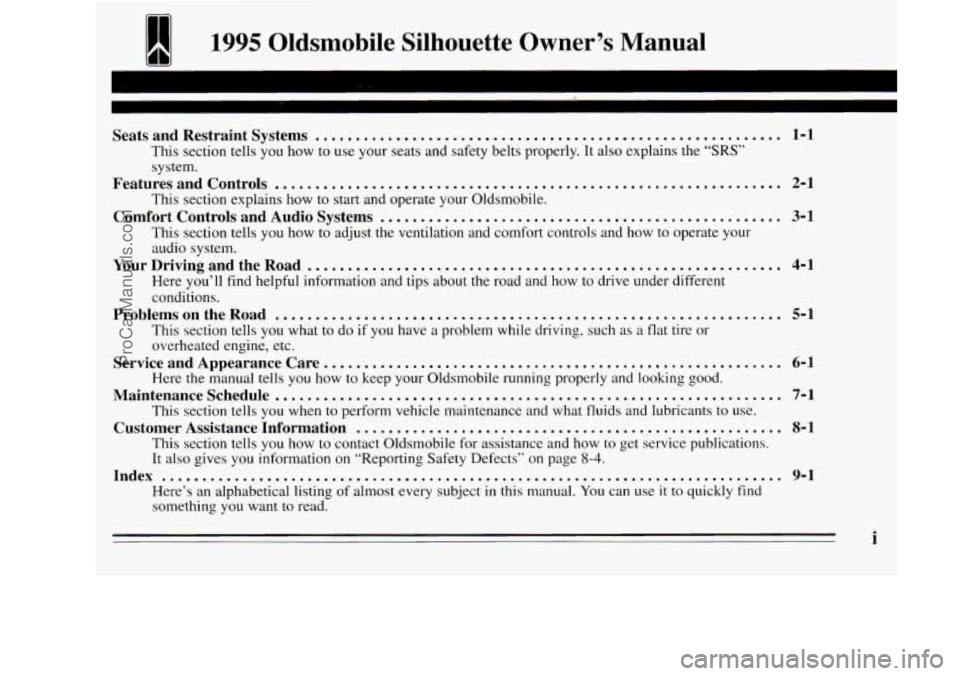
1995 Oldsrnobile Silhouette Owner’s Manual
Seats and Restraint Systems .......................................................... 1-1
This section tells you how to use your seats and safety belts\
properly. It also explains the “SRS” system.
This section explains how to start and operate your Oldsmobile.\
Features and Controls ............................................................... 2-1
Comfort Controls and Audio Systems ..............
This section tells you how to adjust the ventilation and audio system.
Your Driving and the Road .......................
Here you’ll find helpful information and tips about the
conditions.
Problems on the Road ...........................
.................................... 3-1
comfort controls and how to operate your-
.................................... 4-1
road and how to drive under different
.................................... 5-1
This section tells you what to do if you have a problem while driving, such as a flat tire or
overheated engine, etc.
Service and Appearance Care.. ....................................................... 6-1
Here the manual tells you how to keep your Oldsmobile running \
properly and looking good.
Maintenanceschedule ............................................................... 7-1
This section tells you when to perform vehicle maintenance and what fluids and lubricants to use.
Customer Assistance Information ..................................................... 8-1
This section tells you how
to contact Oldsmobile for assistancc and how to get service publications.
It also gives you information on “Reporting Safety Defects”\
on page
8-4.
Index ........................................................................\
..... 9-1
Here‘s an alphabetical listing of almost every subject in this manual. You can use it to quickly find
something you want
to read.
i
ProCarManuals.com
Page 133 of 390
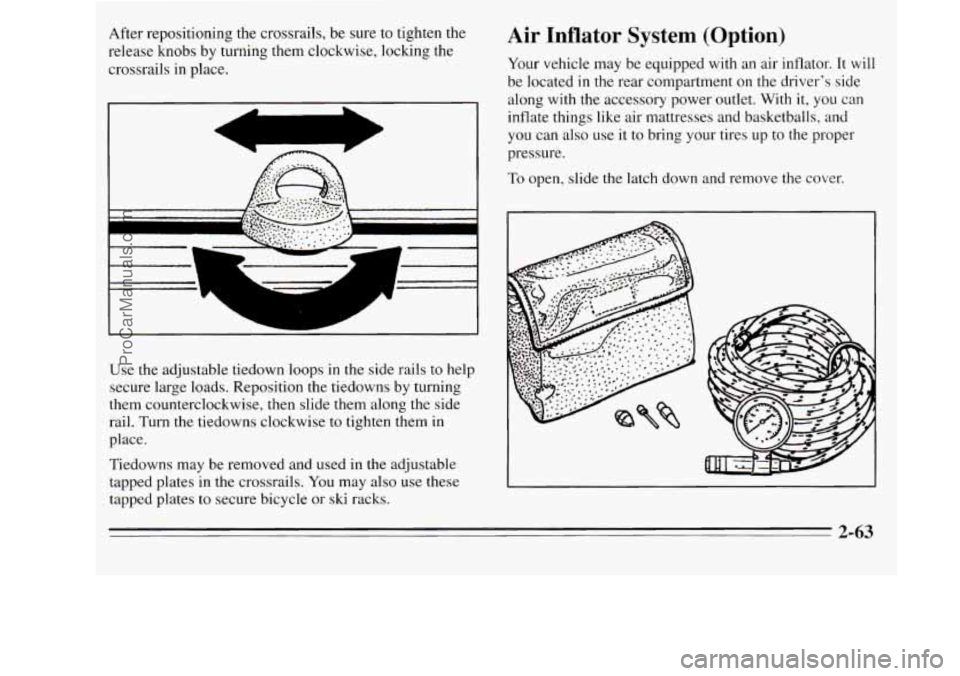
After repositioning the crossrails, be sure to tighten the
release knobs by turning them clockwise, locking the
crossrails in place.
--
L A
Use the adjustable tiedown loops in the side rails to help
secure large loads. Reposition the tiedowns by turning
them counterclockwise, then slide them along the side
rail. Turn the tiedowns clockwise
to tighten them in
place.
Tiedowns may be removed and used in the adjustable
tapped plates
in the crossrails. You may also use these
tapped plates
to secure bicycle or ski racks.
Air Inflator System (Option)
Your vehicle may be equipped with an air inflator. It will
be located in
the rear compartment on the driver's side
along with the accessory power outlet. With
it, you can
inflate things like air mattresses and basketballs, and
you can also use it to bring your tires up to the proper
pressure.
To open, slide the latch down and remove the cover.
2-63
ProCarManuals.com
Page 204 of 390
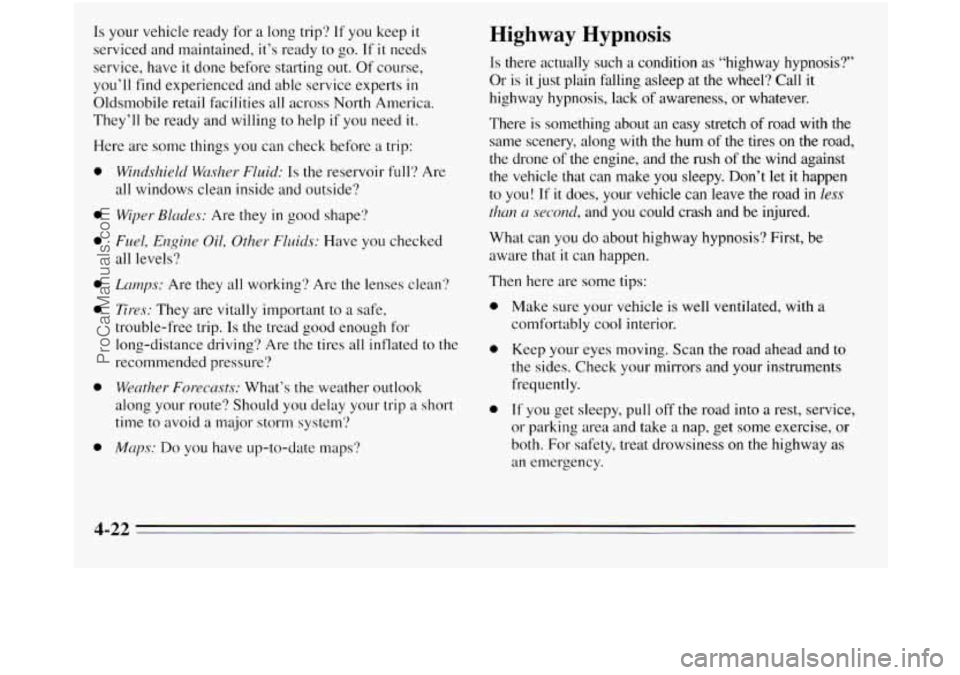
Is your vehicle ready for a long trip? If you keep it
serviced and maintained, it’s ready to go. If it needs
service, have
it done before starting out. Of course,
you’ll find experienced and able service experts in
Oldsmobile retail facilities all across North America.
They’ll be ready and willing
to help if you need it.
Here are some things you can check before a trip:
0
a
a
0
a
a
0
Windshield WLzslzer Fluid: Is the reservoir full? Are
all windows clean inside and outside?
Wiper Blades: Are they in good shape?
Fuel, Engine OiL, Other Fluids: Have you checked
all levels?
Lcmys: Are they all working? Are the lenses clean?
Tires: They are vitally important to a safe,
trouble-free trip.
Is the tread good enough for
long-distance driving? Are
the tires all inflated to the
recommended pressure?
Weather Forecasts: What’s the weather outlook
along your route? Should
you delay your trip a short
time to avoid a major storm system‘?
Maps: Do you have up-to-date maps‘?
Highway Hypnosis
Is there actually such a condition as “highway hypnosis?’
Or is it just plain falling asleep at the wheel? Call it
highway hypnosis, lack
of awareness, or whatever.
There
is something about an easy stretch of road with the
same scenery, along with the hum of the tires on the road,
the drone of the engine, and the rush
of the wind against
the vehicle that can make you sleepy. Don’t
let it happen
to you! If
it does, your vehicle can leave the road in less
than u second, and you could crash and be injured.
What can you do about highway hypnosis? First, be
aware that it can happen.
Then here are some tips:
0
0
0 Make sure your vehicle is well ventilated, with a
comfortably cool interior.
Keep your eyes moving. Scan the road ahead and
to
the sides. Check your mirrors and your instruments
frequently.
If you get sleepy, pull
off the road into a rest, service,
or parking area and take
a nap, get some exercise, or
both. For safety, treat drowsiness on the highway as
an emergency.
4-22
ProCarManuals.com
Page 211 of 390
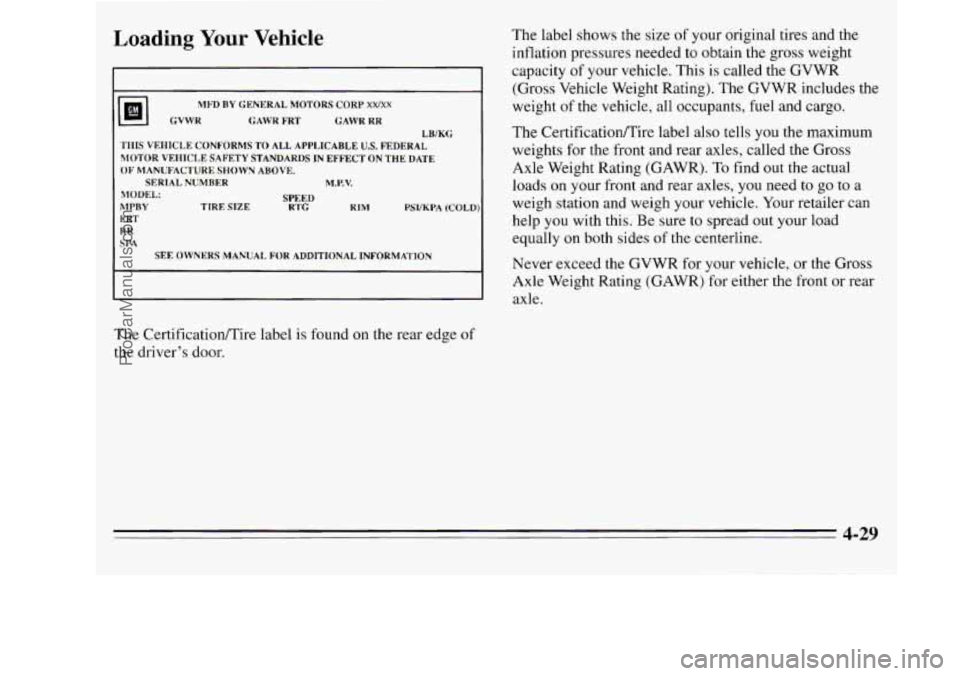
Loading Your Vehicle
11BI CVWR
MFD BY GENERAL MOTORS CORP XWXX
GAWR FRT GAWR RR LB/KG
THIS VEHICLE CONFORMS TO ALL APPLICABLE U.S. FEDERAL
MOTOR VEHICLE SAFETY STANDARDS IN EFFECT ON THE DATE
OF MANUFACTURE SHOWN ABOVE.
SERIAL NUMBER M.P.V.
MODEL:
MPBY
FRT
RR
SPA
SPEED
TIRE SIZE RTG RIM PSI/KPA (COLD
SEE OWNERS MANUAL FOR ADDITIONAL INFORMATION
The CertificatiodTire label is found on the rear edge of
the driver's door. The label
shows the size
of your original tires and the
inflation pressures needed to obtain the gross weight
capacity of your vehicle. This is called the GVWR
(Gross Vehicle Weight Rating). The GVWR includes the
weight
of the vehicle, all occupants, fuel and cargo.
The CertificatiodTire label also tells you the maximum
weights for the front and rear axles, called the Gross
Axle Weight Rating (GAWR). To find out the actual
loads on your front and rear axles,
you need to go to a
weigh station and weigh your vehicle. Your retailer can
help you with this. Be sure to spread out your load
equally on both sides of the centerline.
Never exceed the GVWR for your vehicle,
or the Gross
Axle Weight Rating (GAWR) for either the front or rear
axle.
4-29
ProCarManuals.com
Page 216 of 390

If you’re using a “dead-weight” hitch, the trailer tongue
(A) should weigh 10% of the total loaded trailer weight
(B). If you have a “weight-distributing” hitch, the trailer
tongue (A) should weigh
12% of the total loaded trailer
weight (B).
After you’ve loaded your trailer, weigh the trailer and
then the tongue, separately, to see if the weights are
proper. If they aren’t, you may be able to get them right
simply by moving some items around in the trailer.
Total Weight on Your Vehicle’s Tires
Be sure your vehicle’s tires are inflated to the limit for
cold tires. You’ll find these numbers on the
CertificatiordTire label at the rear edge of the driver’s
door or see “Tire Loading” in the Index.
Then be sure
you don’t go over the GVW limit for your vehicle,
including the weight of the trailer tongue.
Hitches
It’s important to have the correct hitch equipment.
Crosswinds, large trucks going by, and rough roads are a
few reasons why you’ll need the right hitch. Here are
some rules to follow:
0 If you’ll be pulling a trailer that, when loaded, will
weigh more than
2,000 pounds (900 kg), be sure to
use a properly mounted, weight-distributing hitch
and sway control
of the proper size. This equipment
is very important for proper vehicle loading and
good handling when you’re driving.
Will you have to make any holes in the body of your
vehicle when you install a trailer hitch?
If you do,
then be sure to seal the holes later when you remove
the hitch. If you don’t seal them, deadly carbon
monoxide
(CO) from your exhaust can get into your
vehicle (see “Carbon Monoxide” in the Index). Dirt
and water can, too.
0 The bumpers on your vehicle are not intended for
hitches.
Do not attach rental hitches or other
bumper-type hitches to them. Use only a
frame-mounted hitch that does not attach to
the
bumper.
4-34
ProCarManuals.com
Page 246 of 390

If a Tire Goes Flat
It’s unusual for a tire to “blow out” while you’re driving,
especially if
you maintain your tires properly. If air goes
out
of a tire, it’s much more likely to leak out slowly.
But if
you should ever have a “blowout,” here are a few
tips about what to expect and what to do:
If a front tire fails, the flat tire will create
a drag that
pulls the vehicle toward that side. Take your foot off the
accelerator pedal and grip the steering wheel firmly.
Steer to maintain lane position, then gently brake to
a
stop well out of the traffic lane.
A rear blowout, particularly on a curve, acts much like a
skid and may require the same correction you’d use in a
skid. In any rear blowout, remove your foot from the
accelerator pedal. Get the vehicle under control by
steering the way you want
the vehicle to go. It may be
very bumpy and noisy, but you can still steer. Gently
brake to a stop, well
off the road if possible.
If
a tire goes flat, the next part shows how to use your
jacking equipment
to change a flat tire safely.
Air Inflator (Option)
Your vehicle may have an air inflator for use in bringing
tires up to the proper pressure.
To learn about it, see
“Air Inflator System’’ in the Index.
Changing a Flat Tire
If a tire goes flat, avoid further tire and wheel damage
by driving slowly to
a level place. Turn on your hazard
warning flashers.
5-24
ProCarManuals.com
Page 249 of 390
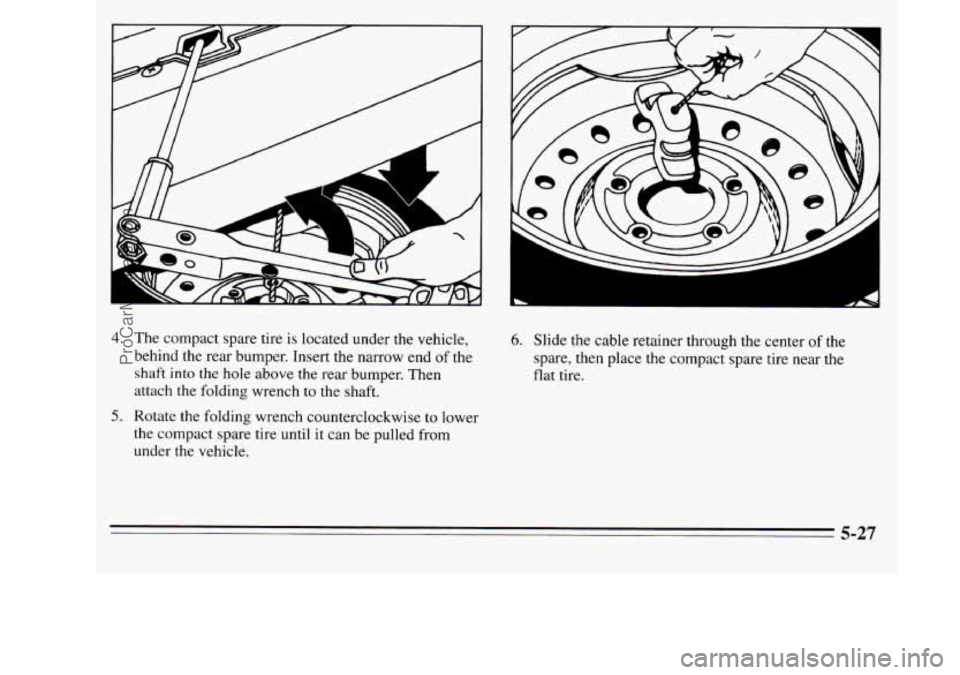
L
4.
5.
The compact spare tire is located under the vehicle,
behind the rear bumper. Insert the narrow end
of the
shaft into the hole above
the rear bumper. Then
attach the folding wrench to the shaft.
Rotate the folding wrench counterclockwise to lower
the compact spare tire until it can be pulled from
under the vehicle.
6. Slide the cable retainer through the center of the
spare, then place the compact spare tire near the
flat tire.
5-27
ProCarManuals.com
Page 251 of 390
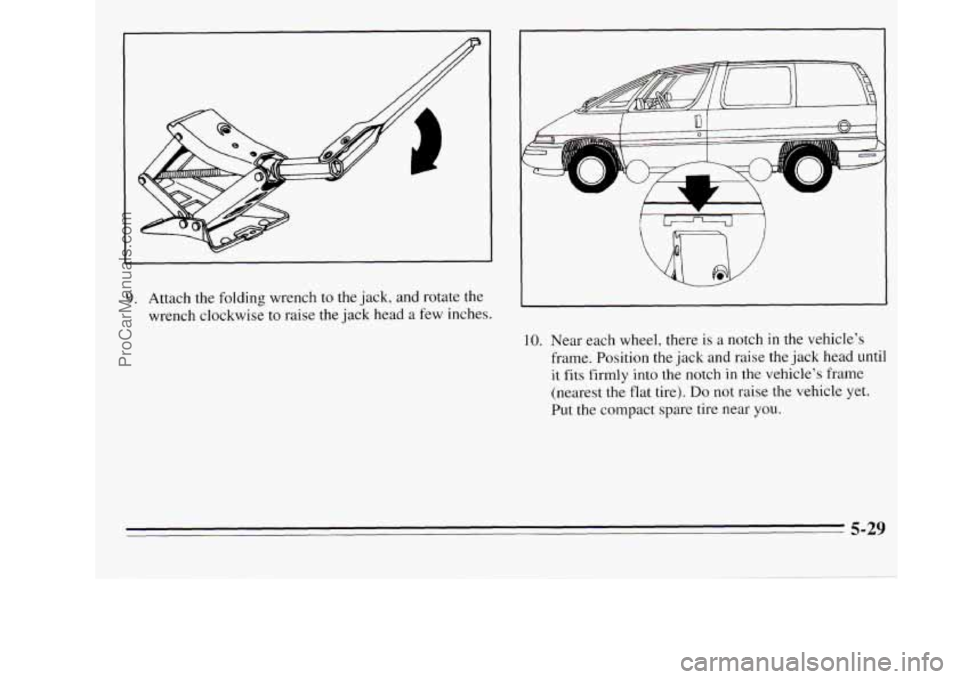
9. Attach the folding wrench to the jack, and rotate the
wrench clockwise to raise the jack head a few inches.
I L L.
Gn J
IO. Near each wheel, there is a notch in the vehicle's
frame. Position the jack and raise the jack head
until
it fits firmly into the notch in the vehicle's frame
(nearest the flat tire).
Do not raise the vehicle yet.
Put the compact spare tire near you.
5-29
ProCarManuals.com